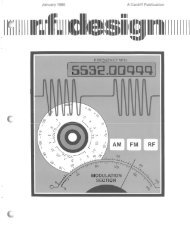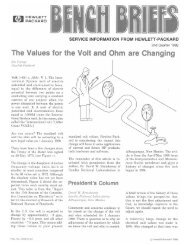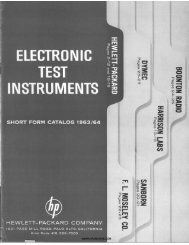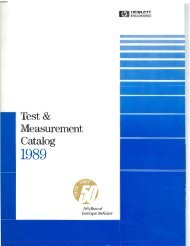175A - HP Archive
175A - HP Archive
175A - HP Archive
You also want an ePaper? Increase the reach of your titles
YUMPU automatically turns print PDFs into web optimized ePapers that Google loves.
Section V<br />
Paragraphs 5-77 to 5-85<br />
Supply<br />
*6.3V<br />
cont’d<br />
Symptom<br />
Low output<br />
(Voltmeter<br />
from +6.3V<br />
to -6.3V<br />
output)<br />
5-77. HIGH-VOLTAGE POWER SUPPLY.<br />
Procedure Effect<br />
Reconnect blue wire and measure<br />
voltage from collector of Q483<br />
to emitter<br />
Short collector of Q484 to emitter<br />
Check -100 volt supply output<br />
Short collector of Q483 to emitter<br />
Remove short from Q483 and meas-<br />
ure voltage from collector of<br />
Q483 to emitter<br />
Measure voltage from collector of<br />
Q484 to emitter<br />
5-78. Waveforms and dc voltages are given as a<br />
troubleshooting aid on the high-voltage power-supply<br />
schematic diagram, figure 5-31.<br />
5-79. The cause of an output voltage whichistoo high<br />
or too low can best be isolated by measuring dc volt-<br />
ages. Start with the resistor divider string composed<br />
of resistors R328 through R337. Then checkvoltages<br />
on regulator tube V306 and rf oscillator tube V301.<br />
5-80. The cause of loss of regulation can also best<br />
be isolated by this method. A changein the crt cath-<br />
ode voltage in the positive direction should be sensed<br />
by V306 and appear as apositive change at the screen<br />
grid, pin 9, of V301. Theplatevoltage of V301 should<br />
then increase accordingly. Likewise, a negative<br />
change in crt cathode voltage should cause the plate<br />
voltage of V301 to decrease.<br />
5-81. VERTICAL AMPLIFIER.<br />
5-82. As a troubleshooting aid, nominal dc voltages<br />
and signal waveforms are given on the vertical-<br />
amplifier schematic diagram, figure 5-18.<br />
5-83. UNBALANCE. Unbalance in direct-coupled<br />
differential amplifier Vl-V4 and V7-V9 can be isolated<br />
by measuring the dc voltages on the various tube<br />
elements. In order to eliminate the effect of any<br />
unbalance in the vertical plug-inunit, short pins 2 and<br />
7 of V1 together. Since a properly operating differ-<br />
ential amplifier has equal voltages on each side of the<br />
amplifier, another method may be used to isolate an<br />
unbalanced stage. Proceed as outlined in table 5-6.<br />
5-16<br />
0 volt<br />
Greater than 2 volts<br />
Trouble<br />
Q483 shorted<br />
Q483 good<br />
Output drops Q484 open<br />
Normal Trouble in k6.3V<br />
supply<br />
Abnormal Trouble in -lOOV<br />
supply<br />
Output remains low<br />
Output rises<br />
Model <strong>175A</strong><br />
Q481 or Q482 open<br />
Q481 and Q482 good<br />
Greater than 10 volts Q483 open<br />
Approx 2.5 volts Q483 good<br />
0 volt Q484 shorted<br />
Greater than 2 volts Q484 good<br />
Measure voltage across CR483 0 volt CR483 shorted<br />
6 volts CR483 good<br />
5-84. IMPROPER GAIN. Insure that the vertical<br />
plug-in unit gain is correct and that the gain of the<br />
amplifier cannot be set properly by adjusting Gain<br />
Control R45. If not, mechanically center R45, and<br />
set up the conditions of waveform measurements<br />
given in the vertical-amplifier schematic diagram<br />
notes, figure 5-18. To isolate the cause of abnormal<br />
gain, check the gain of each stage of the amplifier<br />
against the waveforms given in figure 5- 18 starting<br />
from the input.<br />
5-85. COMPRESSION. The compression of the ver-<br />
tical amplifier can be checked in the following manner:<br />
a. Connect a 1-kc sine wave signal to vertical<br />
INPUT.<br />
b. Connect a high-impedance ac voltmeter isolated<br />
from ground to the vertical crt deflection plates, D3<br />
and D4. CAUTION: +300 VOLTS present on both<br />
terminals.<br />
c. Vertically center the trace on the crt, and ad-<br />
just the sine wave amplitude and vertical SENSITIVITY<br />
for a reading of 1.0 volt on voltmeter.<br />
d. Position the trace to the top of graticule.<br />
e. The voltmeter reading should be 1.0 volt *0.05<br />
volt.<br />
f. Position the trace to the bottom of graticule.<br />
g. The voltmeter reading should be 1.0 volt *0.05<br />
volt.<br />
01 526-2
















